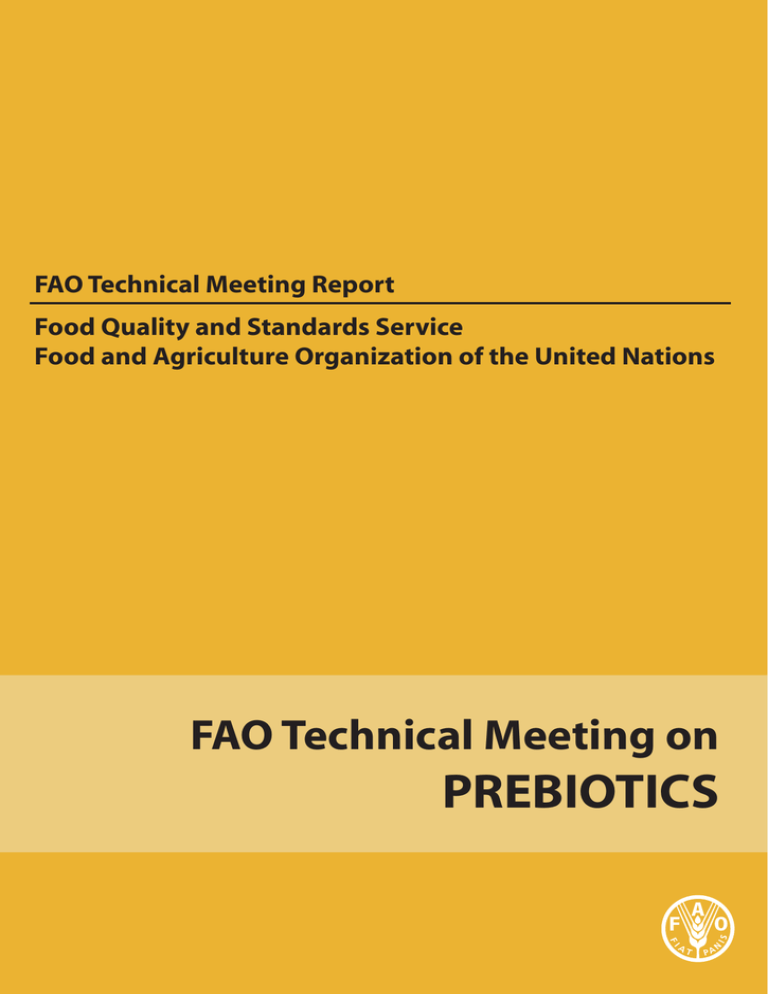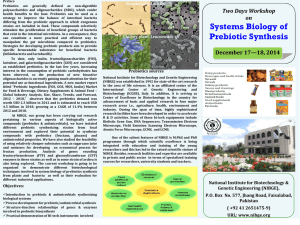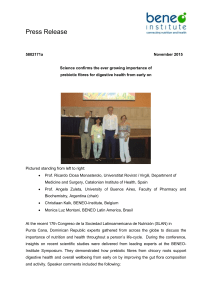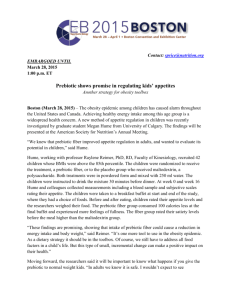FAO Technical Meeting on Prebiotics - AAT
advertisement

FAO Technical Meeting Report Food Quality and Standards Service Food and Agriculture Organization of the United Nations FAO Technical Meeting on PREBIOTICS FAO TECHNICAL MEETING ON PREBIOTICS Food Quality and Standards Service (AGNS) Food and Agriculture Organization of the United Nations (FAO) September 15-16, 2007 This report was prepared for the Food Quality and Standards Service (AGNS), Food and Agriculture Organization of the United Nations (FAO) based on the technical meeting convened by AGNS/FAO (FAO secretariat: Maya Pineiro, Senior Officer, AGNS) with the international experts namely: NilsGeorg Asp, Oscar Brunser, Sandra Macfarlane (Chair), Lorenzo Morelli, Gregor Reid and Kieran Tuohy (Rapporteur). The views expressed in this publication are those of the author(s) and do not necessarily reflect the views of the Food and Agriculture Organization of the United Nations (FAO). The designations employed and the presentation of material in this information product do not imply the expression of any opinion whatsoever on the part of FAO concerning the legal or development status of any country, territory, city or area or of its authorities, or concerning the delimitation of its frontiers or boundaries. For further information, please contact: Food Quality and Standards Service Nutrition and Consumer Protection Division Food and Agriculture Organization of the United Nations Viale delle Terme di Caracalla 00153, Rome, Italy Fax: (+39) 06 57054593 E-Mail: food-quality@fao.org Web site: www.fao.org/ag/agn/agns/index_en.stm Table of Contents 1. 2. 3. Objective of the Meeting.................................................................................................... 4 Current prebiotic standing and state of the art ................................................................... 4 Defining the term prebiotic ................................................................................................ 5 3.1. Definition ................................................................................................................... 6 3.2. Qualifications ............................................................................................................. 6 4. How to evaluate and substantiate that a product is a prebiotic .......................................... 6 4.1. Product specification/characteristics of the prebiotic................................................. 6 4.2. Functionality............................................................................................................... 6 4.3. Qualifications ............................................................................................................. 7 4.4. Safety.......................................................................................................................... 7 5. Management issues ............................................................................................................ 7 6. Monitoring.......................................................................................................................... 8 7. Future research areas .......................................................................................................... 8 Figure 1: ................................................................................................................................ 9 8. References ........................................................................................................................ 10 9. List of Participants ........................................................................................................... 11 1. Objective of the Meeting This Technical Meeting of experts was convened to begin discussions on guidelines, recommended criteria and methodology for conducting a systematic approach for the evaluation of prebiotics, leading to their safe and efficacious use in food. The purpose was to discuss the prebiotic concept and its application to human health. An aim was to determine if prebiotics is an area of food research which would benefit from an Expert Consultation drawn from independently recognised leading experts convened under the auspices of the FAO. Prebiotics have become a recognised functional food commodity. The Technical Meeting concluded that advances in prebiotic research provide sufficient substance for the FAO to consider a full Expert Consultation. 2. Current prebiotic standing and state of the art Currently, there are no industry-wide accepted guidelines governing the usage of the term prebiotic on food products. The market for prebiotics in food is growing rapidly. A 2007 report on the world prebiotic market states that there are over 400 prebiotic food products and more than 20 companies producing oligosaccharides and fibres used as prebiotics [1]. A Frost & Sullivan review reported that the European prebiotics market is currently worth €87 million, and will reach €179.7 million by 2010. This is a dramatic growth spurt, in part explained by the increase in diversity of food products to which prebiotics have been added. The basis for the expanded use of prebiotics is several-fold, not the least of which is a belief that modern day humans do not ingest sufficient quantities of lactic acid bacteria or their growth stimulants including non-digestible carbohydrates. In addition, there is a growing recognition that events taking place in the intestine and influenced by microbes, have major consequences for human health. Thus, not only are prebiotics being examined for antipathogenic effects (such as inhibiting adhesion of pathogenic organisms to the gut mucosa), but they are also being developed to decrease faecal transit time, lower cholesterol and the glycaemic response, improve bone health, lower daily energy (fat) intake, relieve symptoms of inflammatory bowel disease, and attempt to lower colon cancer rates [2]. The latter effects are also promoted for dietary fibres, and this raises the question of if and how prebiotics are differentiated from, or the same as, dietary fibres. increases, along with our understanding of how this complex and diverse collection of bacteria functions, we now recognise that a beneficial modulation of the microbiota encompasses far more than bifidogenesis. Common prebiotics in use include inulin, fructo-oligosaccharides (FOS), galactooligosaccharides (GOS), soya-oligosaccharides, xylo-oligosaccharides, pyrodextrins, isomalto-oligosaccharides and lactulose. The majority of studies have so far focused on inulin, FOS and GOS [5, 6]. These saccharides have now a long history of safe use and are generally regarded as safe, although there is some concern over increased gas production with some compounds, particularly when ingested in higher amounts or during the first few days of intake. There is also a range of new prebiotic compounds emerging, and these include: pecticoligosaccharides, lactosucrose, the sugar alcohols, gluco-oligosaccharides, levans, resistant starch, xylosaccharides and soy-oligosaccharides. These compounds have been studied to varying degrees in vitro, in animal feeding studies, but rarely in human feeding studies. Novel compounds new to the human diet fall under the European regulatory category of “novel foods” and will require legislated levels of safety and toxicological assessment before they can be included in food products. However, little legislation exists governing the use of the word “prebiotic” itself on functional food products and there is a growing collection of commercially available products which bear the prebiotic label but for which supportive scientific literature is sparse or lacking all-together. The call for a scientific evaluation of the functional and health properties of prebiotics is thus timely. The FAO Technical Meeting on Prebiotics addressed guidelines, recommended criteria and methodologies for conducting a systematic approach for the evaluation of prebiotics leading to their safe and efficacious use in food. 3. Defining the term prebiotic The existing definitions of a prebiotic, as stated above, while differentiating this class of nondigestible food ingredient within the dietary fibres and broadly serving the more common and well studied prebiotic oligosaccharides, is restrictive in its applicability for target sites outside the gastrointestinal tract. It is also restricted by necessitating a single mechanism of action (e.g. anti-adhesive activities) in addition to the selective changes in the composition and/or activity in the gastrointestinal microbiota. These definitions too, were drawn up early in the current wave of interest surrounding the impact of the gut microbiota on human health and disease, specifically, before metagenomic demonstration of the high species richness, novelty (with up to 70% of the gut microbiota commonly categorised as “new to science” upon direct 16S rRNA gene fragment sequencing) and degree of metabolic cross-feeding or codependence within the gut microbiota. The stipulation of selective fermentation or selective increase in growth and/or activity encompassed within these current definitions, has become synonymous with the preferential increased abundance of bifidobacteria and/or lactobacilli. However, this is now inadequate to describe a beneficial modulation of a microbiota dominated by members of the Clostridium coccoides, C. leptum groups and the Bacteroides, regarded as key species together with the bifidobacteria in saccharolytic fermentation within the colon. These considerations and their implications warrant a reconsideration of the prebiotic definition itself. The Technical Meeting proposes a broader definition to encompass new prebiotics, and to more accurately reflect current understanding of the microbial ecology of the human microbiota. This revised definition follows. 3.1. Definition A prebiotic is a non-viable food component that confers a health benefit on the host associated with modulation of the microbiota. 3.2. Qualifications 1. Component – not an organism or drug; a substance that can be characterized chemically; in most cases this will be a food grade component. 2. Health benefit – measurable and not due to absorption of the component into the bloodstream or due to the component acting alone; and over-riding any adverse effects 3. Modulation – show that the sole presence of the component and the formulation in which it is being delivered changes the composition or activities of the microbiota in the target host. Mechanisms might include fermentation, receptor blockage or others. A prebiotic can be a fibre but a fibre need not be a prebiotic. 4. How to evaluate and substantiate that a product is a prebiotic 4.1. Product specification/characteristics of the prebiotic The component to which the claim of being prebiotic is attributed, must be characterized for any given product. This includes: • • • • Source, origin Purity Chemical composition and structure Vehicle, concentration and amount in which it is to be delivered to the host 4.2. Functionality At a minimum, there needs to be evidence of a correlation between the measurable physiological outcomes and modulation of the microbiota at a specific site (primarily the gastrointestinal tract, but potentially also other sites such as vagina and skin). Need to correlate a specific function at a specific site with the physiological effect and its associated timeframe. • Within a study, the target variable should change in a statistically significant way and the change should be biologically meaningful for the target group consistent with the claim to be supported. • • • Substantiation of a claim should be based on studies with the final product type, tested in the target host. A suitably sized randomized control trial (compared to placebo or a standard control substance) is required, preferably with a second independent study. Examples of physiological outcomes due to administration of prebiotics could be: satiety (measured towards carbohydrates, fats, total energy intake); endocrine mechanisms regulating food intake and energy usage in the body; effects on absorption of nutrients (e.g. calcium, magnesium, trace elements, protein); reduced incidence or duration of infection; blood lipid and classic endocrine parameters; bowel movement and regularity; markers for cancer risk; changes in innate and acquired immunity that are evidence of a health benefit. 4.3. Qualifications • • Bifidogenic effects are not sufficient without demonstrated physiological health benefits. It is recognized that at this time, determining events that take place within compartments of the intestine are often difficult. Until such times as specific site sampling or more sophisticated methods can reliably link microbiota modulation with health benefits, faecal analysis will be deemed suitable, with limitations. 4.4. Safety As with any food component, safety parameters are established by all national regulations. It is recommended that the following issues need to be covered in any safety assessment of a prebiotic final product formulation: • • • • If , according to local legislation, the product has a history of safe use in the target host, such as GRAS or its equivalents, then it is suggested that further animal and human toxicological studies may not be necessary. Safe consumption levels with minimal symptoms and side effects should be established. The product must not contain contaminants and impurities. Based upon current knowledge, the prebiotic should not alter the microbiota in such a way as to have long term detrimental effects on the host. 5. Management issues • • Production – the onus is on the manufacturer to ensure substances considered prebiotics should have purity and consistency in composition between product lots. Formulation and storage – It is recommended that the limit of stability in different • • disease prevention, treatment and risk reduction claims. A number of documents available in the public domain, such as PASSCLAIM, EFSA guidelines and others [7,8], provide criteria for evaluating the quality of data suitable for making health claims on food and food components. The status of prebiotics is not established on an international basis. The term prebiotic must be used only when a health benefit related to modulation of the target site microbiota has been demonstrated in the target host. The issues of product specific testing were considered. The consensus was that the onus should be on the producer to show that a new formulation e.g. yoghurt, is equivalent to the one (e.g. dried powder) proven in target host studies to confer the prebiotic effect. 6. Monitoring The Technical Meeting recommends that prebiotic producers, medical professionals and public health officers consider some form of system to monitor the health outcomes of longterm prebiotic administration. This is suggested as a means to gain insight into potential side effects as well as assess long-term benefits. A necessary prerequisite for surveillance is a proper trace-back system. 7. Future research areas • It is recognised that there are numerous potential new applications being considered for prebiotic use e.g. prevention and or management of type 2 diabetes mellitus; drug bioavailability; effects on autoimmune diseases and allergy; modulation of pathogenic biofilms. There is a need for more randomised, placebo controlled clinical trials with adequate statistical power. We encourage publication in peer-reviewed journals of all clinical trials, whether the outcome is positive, negative or adverse. • It is recognised that prebiotics may be used in conjunction with probiotics; this is considered a synbiotic. Depending on the nature of the two components, the net effect may not be synergistic. We recommend that the term synbiotic only be used if the net health effect is synergistic. It is also recommended that the issue of synbiotics be addressed by a separate Technical Meeting. Figure 1: 8. References 1. http://www.ubic-consulting.com/template/fs/The-World-Prebiotic-IngredientMarket.pdf 2. Conway, P. Prebiotics and human health: the state-of-the-art and future perspectives. Scand. J. Nutrition/Naringsforskning 2001; 45:13-21. 3. Gibson, GR, Roberfroid, M. Dietary modulation of the human colonic microbiota: introducing the concept of prebiotics. J. Nutr. 1995; 125:1401-1412. 4. Gibson, GR, Probert, HM, Van Loo, J, Rastall, RA, Roberfroid, M. Dietary modulation of the human colonic microbiota: updating the concept of prebiotics. Nutr. Res. Rev. 2004; 17:259-275. 5. Macfarlane, S, Marfarlane, GT, Cummings, JH. Prebiotics: key issues. Aliment. Pharmacol. Ther. 2006; 24:701-714. 6. Macfarlane, GT, Steed, H, Macfarlane, S. Bacterial metabolism and health-related effects of galacto-oligosaccharides and other prebiotics. J. Appl. Microbiol. 2008; 104: 305-344. 7. Aggett PJ, Antoine J-M, Asp N-G, Bellisle F, Contor L, Cummings JH, Howlett J, Müller DJG, Persin C, Pijls LTJ, Rechkemmer G, Tuitelaars S, Verhagen H. PASSCLAIM Process for the Assessment of Scientific Support for Claims on Foods. Consensus on Criteria. E J Nutr 2005; 44 (Suppl 1):i/1-I/30. 8. Anonymous. EFSA Scientific and technical guidance for the preparation and presentation of the application for authorization of a health claim. http://www.efsa.europa.eu/EFSA/Scientific_Opinion/nda_op_ej530_guidance_%20he alth_claim_en.pdf.pdf (Accessed 5 Oct 2007) 9. List of Participants International Experts Nils-Georg Asp Professor Applied Nutrition Lund University and Director, SNF Swedish Nutrition Foundation, Sweden E-mail: asp@snf.ideon.se Oscar Brunser Ultrastructure Laboratory Institute of Nutrition and Food Technology (INTA) and University of Chile Santiago, Chile E-mail: obrunser@inta.cl Gregor Reid University of Western Ontario and Canadian R&D Centre for Probiotics F2-116, Lawson Health Research Institute, 268 Grosvenor Street, London, Ontario N6A 4V2, Canada E-mail: gregor@uwo.ca Kieran Tuohy (Rapporteur) Food Biosciences University of Reading United Kingdom E-mail: k.m.tuohy@reading.ac.uk FAO Sandra Macfarlane (Chair) Division of Pathology and Neuroscience Dundee University, United Kingdom E-mail: s.macfarlance@dundee.ac.uk Lorenzo Morelli Istituto di Microbiologia UCSC, Italy E-mail: Lorenzo.morelli@unicatt.it Maya Piñeiro Senior Officer Food Quality and Standards Service, Food and Agriculture Organization of the United Nations (FAO), Rome, Italy E-mail: Maya.Pineiro@fao.org




